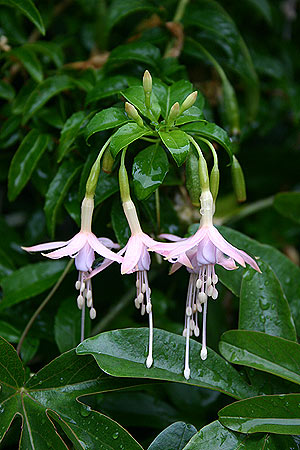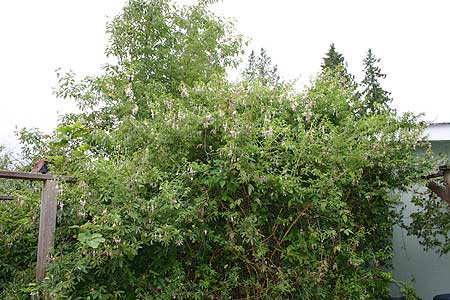Fuchsia magellanica var. molinae
Family Name: Onagraceae
Pronounced: FEWK-see-ah (Most people pronounce it FEW-shah.) mah-geh-LAN-ih-kuh
Quick Jumps
Growing Guide
Rainy Side Notes
GROWING GUIDE

Origin:
Chile, Argentina.
Plant Group:
Subshrub.
Hardiness:
Sunset zones: 2-9, 14-24.
USDA zones: 7-10.
Mature size:
Height: 5-8 feet (1.5-2.4 m).
Width: 5-10 feet (1.5-3 m).
Flowering period:
Summer until first frost.
Flowering attributes:
Pink buds, fading to white as the sepals open; very light pink corollas.
Light:
Full sun to partial shade.
Soil:
Fertile, moist, well-drained soil.
Feeding:
Fertilize with a complete organic fertilizer in spring and again in July.
Propagation Methods:
Softwood cuttings in spring. | Semi-ripe cuttings in late summer.
Pruning Methods:
Prune in early spring when new growth begins to shape, or trim out dead branches.
Rainy Side Notes

Fuchsia magellanica var. molinae happens to be one of my favorite of the magellanica fuchsias. Unlike most magellanicas, with bright red and purple flowers, this species' corollas are soft lavender, with sepals that are almost white, with a blush of pink.
My resources say Fuchsia magellanica var. molinae attains a height of five or six feet when mature. However, in my garden the fuchsia is eight feet tall by almost as wide, after seven years. It grew a lot larger than I anticipated and turned out to be too big for the space it is in, serving partially as scaffolding for a passionflower vine, Passiflora caerulea, on one end, and Clematis montana on the other. Both vines chose the fuchsia to entangle themselves, along with the structures they were given to climb. These robust climbers could easily overtake a tree. Yet this fuchsia stands proud with their weight on many of its branches. It is a pleasure to find one of the large exotic looking passionflowers blooming in the middle of the fuchsia, surrounded by its dainty, dangling flowers.
We have to prune the fuchsia drastically in order to get to our garbage corral. Hardier than other fuchsias, so far it has not died back to the ground during colder winters, which may explain why it is larger than what the books report it should be. Unfortunately, the plant can't read and is reaching for superstar status in the small space it was given. I am taking cuttings this year and planning to make a hedge out of it.
When the plant was younger, I used to fertilize it frequently during the growing season. I haven't fertilized it for a few years now. I monitor it for any fertilizing needs, but so far, it doesn't appear to need any. I certainly do not want to encourage it to grow larger. Once established, it has been very drought tolerant, sometimes needing only a few waterings during the severe droughts we had recently.
The foliage remains evergreen in my garden; however, the fuchsia will be semi-deciduous to completely losing its leaves or dying back to the ground in colder areas of the Pacific Northwest.
Photographed in author's garden.

Gardening for the Homebrewer: Grow and Process Plants for Making Beer, Wine, Gruit, Cider, Perry, and More
By co-authors Debbie Teashon (Rainy Side Gardeners) and Wendy Tweton
Copyright Notice | Home | Search | Perennials

